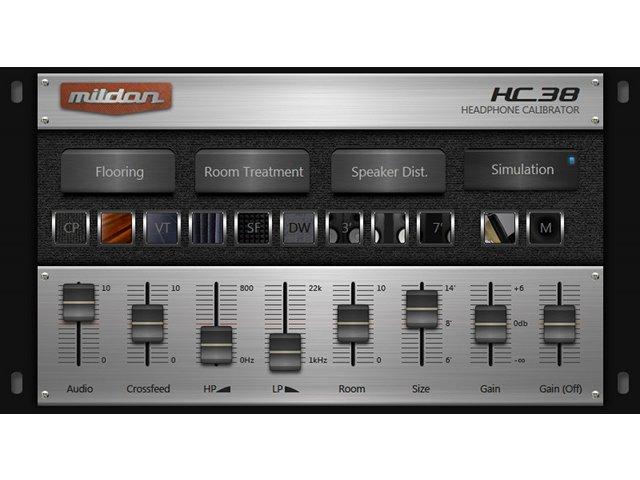
- Headphone crossfeed plugin software#
- Headphone crossfeed plugin plus#
- Headphone crossfeed plugin mac#
Why? Because there can be surprises or discoveries, as we will see. MeasurementsĭSP plugins still need to be measured despite that their effects are usually better documented than of hardware units. And we took care of this by lowering the digital volume of the player (see Part 1), giving some headroom to the audio signal before it gets upsampled. This is assuming that the input signal doesn't have intersample peaks.
Headphone crossfeed plugin software#
Thus, there is no reason to worry about going from 44.1 kHz to 96 kHz on the processing chain side, as modern software resamplers should be transparent. So the DAC chip would never "know" what was the track's original sampling rate.
Headphone crossfeed plugin plus#
Also, a lot of good DAC units have an upsampling DSP processor connected before the DAC chip, for upsampling to 192 kHz (TEAC UD-x01), 384 kHz (Cambridge Audio DacMagic Plus and Azur), 768 kHz (!) (Pro-ject DacBox DS2 Ultra), or even an "odd" value of 110 kHz ( Benchmark DAC1). Going up to 192 kHz or higher will consume more CPU resources, and considering a modest amount of effects used, I don't think it's really needed.Īt first, I was hesitating a bit whether should I use an integer multiple of the source sampling rate, that is, 88.2 kHz instead of 96 kHz, but then I realized that converting from 44.1 kHz to 48 kHz can be expressed conceptually as first upsampling with a multiplier of 160, and then downsampling by 147, both being integer multipliers (44100 * 160 / 147 = 48000). Use of higher sampling rates is common in music production world, as they allow using smoother antialiasing filters during processing, and also help reducing the quantization noise.

I run my chain at 96 kHz, even when the source material is at 44.1 kHz. I think that having crossfeed after normalization defeats the purpose of the latter since crossfeed will most likely change the carefully tuned frequency response. Also, if crossfeed is implemented as a plugin, it's possible to add a headphone "normalization" plugin after it. But using a plugin allows to have crossfeed on any DAC / amp, so it's more versatile. An alternative is to use the crossfeed feature of the headphone amplifier or DAC, if it has one. However, I prefer to add them with a DSP plugin rather than with an amplifier.

I think, in small controlled quantities harmonics sometimes can help. It helps to liven up some recordings if they sound too dry and lack "dimension". The next block adds harmonic distortions. I find these to be more pleasant sounding than typical shelving filters of multi-band parametric equalizers. So here is a conceptual diagram of the DSP chain I use:įirst comes a simple 2- or 3-band equalizer employing Baxandall curves.

But if headphones used are known to have some particular tonal issue, like the 6 kHz bump of Sennheiser HD800, adding a "normalizing" plugin could be a good idea. Now I'm less excited, and I will explain why later. Previously, I was also enthusiastic about the idea of headphone frequency response normalization. In addition, we can try adding some psycho-acoustic enhancement by injecting 2nd or 3rd order harmonics (this is roughly equivalent to using a tube amplifier).

So our goals are pretty clear: being able to easily adjust levels of high and low frequencies, and have a crossfeed. This is especially noticeable on recordings that employ some form of "spatial" processing intended for speakers. So clearly, an ability to tweak tonal balance is required.Īlso, when using closed headphones the reproduction sounds unnatural due to super-stereo effect-each ear can hear its own channel only. Also, due to non-linearity of human hearing, even changing playback volume affects perceived tonality. Even if the chain itself is transparent, the combination of recording's frequency balance and the headphone's frequency curve may not suit your taste. I don't believe in the existence of a perfect playback chain that would suit all commercial recordings. I'm not covering Linux and mobile platforms here, sorry.
Headphone crossfeed plugin mac#
In order to route audio from any player program via the DSP processing chain, on Mac we use Audio Hijack, and on Windows-a combination of virtual loopback cables and a plugin host program. We have set up a transparent hardware chain at moderate cost, and decided to make all the necessary adjustments on the software side using DSP plugins. Continuing the topic of my desktop setup for headphone listening, let's recap what we had covered in Part 1.


 0 kommentar(er)
0 kommentar(er)
